How to get a pump out of a well if it is stuck: first aid from professionals
Have you encountered the problem of submersible equipment getting stuck in the shaft and being unable to extract it to the surface? Agree, it’s not a bad idea to pull it out on your own, restoring uninterrupted water supply, and at the same time saving on the cost of visiting a specialist. But you don’t know how to remove the pump from the well without damaging it?
We will tell you how you can cope with this task yourself - the article discusses the most common causes of a stuck pump and methods for removing it. Video recommendations from professionals are provided and the equipment used in this case is reviewed.
The article also contains photographic materials demonstrating methods for removing a submersible pump operated at great depths. The recommendations given will help to cope with the problem if the reason why the unit is stuck, its type and the condition of the casing pipe allow this to be done.
The content of the article:
When can a pump get stuck?
In most cases, well owners have problems with extraction pumping equipment, which has already worked in production for a certain time.
Lifting a deep-well pump is necessary in the following cases:
- carrying out repair work;
- Maintenance;
- replacement with a more powerful or new pump;
- replacing the flush pump with a permanent one.
Much less often, the pump jams in the barrel when trying to lower it to the bottom of the well. The reasons for getting stuck in this case are, as a rule, a mismatch between the size of the pump and the diameter of the casing pipe or the entry of a foreign object into the column that interferes with the descent of the unit.
These two reasons are easily eliminated: pump size and model is picked up before the descent begins, and a foreign object that has fallen into the casing is removed or pushed down.
To prevent the pump from getting stuck when lowering, it is necessary to observe safety measures: carefully inspect the unit and make sure that all its parts are in good condition, avoid getting foreign objects (stones, tools, packaging) into the pipe, use a reliable cable and clamps.
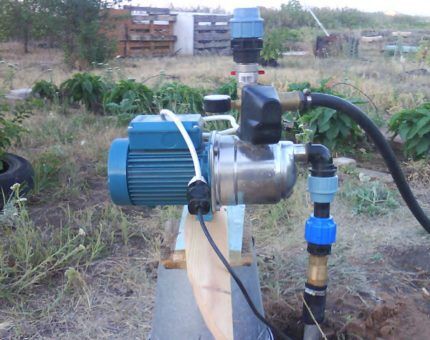
Causes of jams and their elimination
Problems associated with a stuck pump usually occur when lifting it from the well to the surface.
The most common reasons why equipment can get stuck in the shaft:
- sagging rope (cable);
- siltation of the well “on sand”;
- deposits in a well “on limestone”;
- damage to the walls of the casing pipe;
- foreign objects entering the pipe;
- the pump is skewed inside the casing;
- cable break.
If your pump is stuck in aquifer well, then the right decision is to call specialists who have the experience and necessary equipment to safely remove the unit.
But in some cases, you can try to get the pump out yourself by identifying and eliminating the cause of its jamming. Let's consider the described reasons and ways to eliminate them in more detail.
Reason #1 - cable sagging during lifting
If there is sagging in the cable or electrical cable used to lift the pump, the unit gradually pulls upward worse and worse, and at a certain point stops altogether. This happens because a loose cable or electrical cable has become wrapped around the pump housing.
Algorithm for removing a pump that is stuck due to a slack cable or cable:
- Lower the pump to the bottom and carefully align the resulting loop by slowly swinging the cable in different directions and pulling it up.
- If only a cable is used for lifting, then do not forget that the pump is also equipped with an electric cable and a hose, which must be synchronized with each other to avoid sagging of one of the elements and the formation of loops.
- Secure all three elements with clamps. Fastening must be done every 1-1.5 meters.
- Slowly and carefully lift the pump.
This is the most common and easily solved problem. It is very simple to prevent the cable from sagging; to do this, when lowering the pump into the well, it is necessary to tie it in the casing every 2-3 m so that it always remains under slight tension.
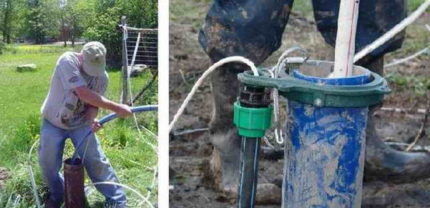
Reason #2 - siltation of the well “on sand”
Siltation of wells with a sandy bottom occurs due to infrequent or improper operation. In this case, the pump ends up in a mud “trap” and you can get it out by alternately tightening and loosening the cable, while slowly swinging the unit in different directions. In this way, it is possible to free the equipment from sludge deposits.
In unused excavations, silt can harden, so before removing the unit, the sediment must first be washed away. To do this, take a fire hose or a flexible hose through which water is supplied to the bottom of the well.
Soaking of sludge deposits can take from 2 to 48 hours. To check whether the pump is free of sludge, you must periodically try to lift it, rocking it from side to side. If the device does not give in, then you should not make excessive efforts, let the soaking of the sludge continue.
The problem of the pump becoming clogged with silt occurs if the well has not been cleaned for several years. Annual preventive cleaning of hydraulic structures and well filters completely eliminates the problem of silting, and therefore equipment jamming.
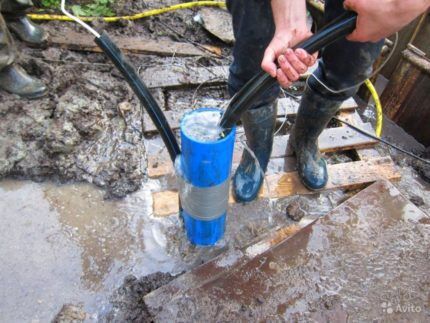
Reason #3 - deposits in a limestone well
Water produced water well made of fractured limestone, contains many salts and metals, which, when interacting with oxygen, form a solid sediment. Such sediment can be seen on the walls of casing pipes.
Exactly the same deposits accumulate on the casing of pumping equipment, forming salt build-ups, the layer of which can reach 5 cm. It is clear that when lifting the pump, its increased dimensions due to deposits will not allow it to pass through the casing pipe.
In this case, there are three ways to solve the problem:
- Flushing the well with water. It is directed into the barrel under high pressure. This method is good when there are few deposits and they can be washed away. In this case, after high-pressure washout, the pump rises upward by means of a rope or cable.
- The use of “folk” anti-scale remedies. Instead of special powders, citric or acetic acid is taken, diluted in water and poured into the well site. Under the influence of acid, salt deposits disintegrate. This method can only be used on a pump whose further operation is not planned, because acids can damage its internal mechanisms.
- Use of chemicals. Anti-scale agents for washing machines, dishwashers, and kettles are perfect for this. The powder must be dissolved in hot water in accordance with the manufacturer’s instructions and the resulting solution must be poured into the well. To increase the effectiveness of anti-scale products, it is recommended to turn on the pump (if it is working) so that the water starts moving.
The disadvantage of the latter method is its high cost: you will need at least 20 packs of anti-scale agent, and in some cases it is necessary to repeat the procedure 2-3 times.

Reason #4 - damage to the casing walls
When lifting the pump, it may get stuck due to mechanical damage. casing pipe.
Such damage includes:
- dent in the casing;
- flattened edge of the pipe;
- roughness of welds;
- displacement of welded parts, etc.
A characteristic symptom indicating that damage to the pipe has become an obstacle to the upward movement of the pump is a dull knock and jamming of the unit, which until that moment had moved along the alignment without problems.
In this situation, a slight change in the position of the pump can help; it must be tilted and slowly rotated while lifting it up. Please note that you need to tilt it just “a little bit”, otherwise you risk breaking the cable and dropping the device into the well.
You should not use excessive force trying to push the pump through a difficult area, as this will lead to complete jamming of the unit inside the well. Practice shows that with minor deformations of the casing and small dimensions of the pump, this method helps in most cases.
If the dimensions of the device are slightly smaller than the cross-section of the casing pipe or the damage to the column is significant, then you will not be able to get the pump yourself, and in some cases this is beyond the power of even specialists.
To prevent equipment getting stuck due to deformation of the casing pipe, it is necessary to carry out high-quality installation of casing columns in compliance with all technological standards and select the correct unit according to its dimensions.
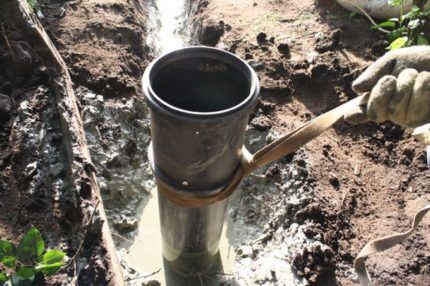
Reason #5 - ingress of foreign objects
The most unpleasant and dangerous situation, which, however, is very easy to prevent. Most often, tools, fasteners, debris, and scraps of plastic bottles get into the casing. To avoid this, you need to carefully prepare for lifting the pump, removing everything unnecessary in the work area.
If a foreign object nevertheless falls inside the pipe and interferes with the lifting of the equipment, then the following steps can be taken:
- Carefully and slowly, without making any effort, rock the pump from side to side, if possible - a small object may slip inside the well, clearing the way for the unit.
- If the upward movement of the pump is impossible, but the device goes down without problems, then you need to lower the pump a little and try to reach the fallen object using a net, hook or rope with a loop.
- In some cases, you can try to push a fallen object using a rigid cable or crowbar. This must be done very carefully, because... There is a high risk of the lifting cable breaking and damaging the pump housing. In this case, you should not make excessive efforts.
If these measures were not enough, and the pump is completely stuck in the well due to a foreign object getting between its body and the walls of the casing pipe, then you need to stop trying to solve the problem yourself.
You should call a team of specialists who will remove the obstacle and lift the pump to the surface without damaging it.
Reason #6 - pump misalignment inside the pipe
The reasons for pump misalignment may be sagging cable, a sharp jerk of the lifting cable, lifting the unit using an electric cable, etc.The following signs indicate the presence of misalignment: the pump rose without problems, but at a certain point the rise slows down and stops, and there is no shock.
Under no circumstances should you continue to pull the device out of the well, because... This will lead to even greater distortion and jamming! The only solution to the problem is to loosen the cable tension and, lowering the pump, try to return it to its original position.
To do this, the lifting cable must be rotated, gradually pulling the pump up; if the unit is stuck again, you can try to rotate the cable in the other direction. When lifting is done using a cable and an electric cable, then by manipulating them one by one it is quite easy to return the device to the required position.
It is advisable to do all this if the pump moves freely in the well up to a certain point and goes down without problems. If the unit is stuck in the well and does not move freely, then it is necessary to call specialists who will remove the device using special tools without harming the pump and the well.
Reason #7 - broken lifting cable
A broken lifting cable is the most difficult case, in which the pump falls to the bottom of the well or gets stuck in the casing. First aid in case of a cable break is to stabilize the unit.
A hose and electric cable are used for this. If the pump has small dimensions and weight, then using a cable and hose it can be carefully pulled to the surface, despite the fact that these elements are not designed for this. However, after using this method, most often you will have to pump replacement for a new unit.

If the pump is heavy, then you cannot pull the electrical cable, this will most likely lead to its breakage. In this case, you need to act quickly: take a thick rope with a metal hook tied to it.
Then carefully lower the rope, trying to hook the pump and pull it up. The hose and electric cable are used to secure and level the device during lifting.
When the cable breaks suddenly and the pump falls into the well along with the hose and electrical cable, you can try to get it out yourself using the following method:
- We take a metal rod of such length that it reaches the fallen/stuck unit.
- We attach a special attachment in the form of a corkscrew to the rod. Such a twisted attachment can be made by a blacksmith, a milling turner, or any ready-made suitable element can be used as an attachment.It is important that the diameter of the turns of the nozzle be such that the rod passes freely through the casing pipe.
- The nozzle is attached to a rod, onto the other end of which a metal rod is placed, which makes it possible to ensure rotation of the structure.
- We lower the rod with the nozzle into the well and, using a rod, screw the “corkscrew” into the pump body. We lift the unit together with the broken cable and hose.
This is a rather complex and difficult to implement method, suitable only for shallow wells. Naturally, further use of equipment raised by such a “corkscrew” will be impossible. You cannot remove a fallen pump without damaging it on your own, and the services of professionals in this case can cost you dearly.
If it is impossible to lift the submersible pump to the surface in any way, then there are two options:
- conservation of the well and drilling of a new one;
- crushing the pump into pieces using a special drilling rig and removing it piece by piece.
Which method should I choose? In each specific case, the owner of the well decides for himself, taking into account many factors. It happens that a well has exhausted its resource or its operation is difficult for some reason, then it is easier and faster to drill a new one.
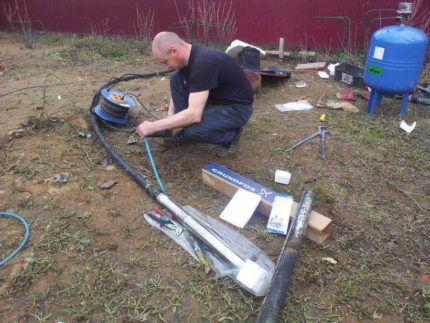
General recommendations for safe lifting
It is easier to prevent a stuck submersible pump than to correct the problem later.
To do this, you need to follow a few simple recommendations:
- Use a reliable, strong and rigid cable. The cable that comes with the submersible pump often does not meet these requirements.Don’t skimp, buy a high-quality cable and fasteners (clamps) made of stainless steel.
- Do not use multi-piece hose. If the hose included with the pump is not long enough, you should not extend it; it is better to buy a new one in one piece. This will reduce the risk of breakage and serve as additional insurance if the cable breaks.
- Select the correct pump size. It should be 2/3 smaller than the diameter of the casing pipe. Thus, the risk of the unit jamming will be significantly reduced even if the pipe is deformed or foreign objects fall into the well.
- Be sure to set the header. It will protect the well from falling debris and various objects.
And remember: when using the methods described above, under no circumstances use brute force when trying to pull the unit to the surface. This will lead to aggravation of the problem: the pump will get stuck even more tightly inside the barrel, the cable may break, and the wall and casing may become deformed.
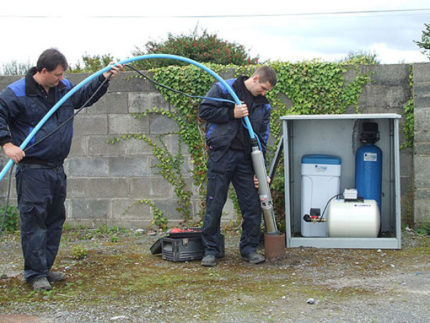
Conclusions and useful video on the topic
Video #1. How to get a pump if it is stuck in a well and how to prevent it from getting stuck:
Video #2. Removing a stuck pump yourself in the following video:
A submersible pump stuck in a well is a serious problem that requires an immediate solution. In this case, as nowhere else, the rule “do no harm” applies, therefore, when attempts to remove the equipment are unsuccessful, the best solution is to call specialists.
Be sure to follow the rules for installing and operating the well, clean it in a timely manner, and then you will never encounter such problems.
We are waiting for your stories about how you independently removed a stuck pump from a wellbore. Perhaps you have a more effective method in your arsenal or have questions. Please write comments in the block below.




I encountered this problem a couple of times, the pump jammed in the well, and it jammed tightly; the first time I started to panic and pull the cable, but I was lucky and didn’t ruin anything. In fact, both times my cable sagged while climbing. The second time I already knew the approximate reason and acted more measuredly. Both times I lowered the pump back to the bottom and, by shaking the cable, removed the loop.
The pump also fell a couple of times. For the first time I panicked about how to get the unit out of the well. He tried something himself, a neighbor came and started lowering a pole with a loop attached to it to the bottom, and they got it out a couple of times. When the pump fell for the second time, I already surfed the Internet, studied information on lifting the pump from the well, and did everything myself. And thank you for helping people!
Trying to pull a stuck pump out of a well is a very hectic job. What can you do? You might even lose your well. You are lucky that you have a shallow well and the pole can reach you.
good article
What to do if everything on the pump breaks and then how to get it out?
a couple of years ago the pump got stuck dead. I couldn’t get it out.
well depth 40 meters.
The fracture of the well apparently was at a depth of 27-30 meters. The pump had to be left, and the new one was lowered only 25 meters. It has been working like this for 2 years - the flight is normal (the old pump still floats below)